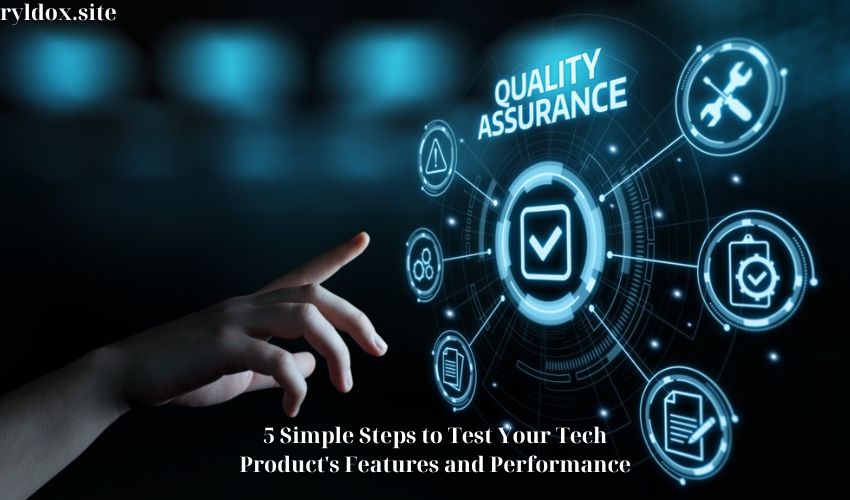“In this article, we will learn how to test the features and performance of a technology product through 5 simple steps. This will help you accurately evaluate the performance of the product and improve your user experience.”
1. Introduction to how to test the features and performance of technology products
During the development of technological products, testing the product’s features and performance is an important step to ensure quality and efficiency. This testing helps evaluate the product’s ability to operate under real-world conditions and determine whether the product meets the user’s requirements and expectations.
2. Method of testing features and performance
There are many methods to test the features and performance of technological products, including:
– Functional testing: Testing each function of the product to ensure proper operation and meeting specific requirements.
– Load testing: For products that need to bear loads such as machinery and equipment, load testing helps ensure the product operates stably under pressure.
– Durability testing: Assessing the product’s ability to withstand force, heat, and abrasion to ensure the product’s longevity and durability.
Note: Feature and performance testing must be performed by experienced professionals with appropriate equipment to ensure the accuracy and reliability of test results.
2. Step 1: Determine the goals of testing and evaluating technology products
To begin the process of testing and evaluating a technology product, it is important to clearly define the goals of the process. Goals may include ensuring that the product meets quality standards, evaluating performance, or identifying improvements that can be made to enhance the product.
2.1 Determine evaluation criteria
First, it is necessary to clearly define the criteria to be evaluated during product testing. These criteria may include quality, performance, stability, security, and compatibility with other systems.
2.2 Determine the scope and method of testing
Once the evaluation criteria have been determined, the appropriate scope and method of testing must be determined. The scope of testing can range from product quality testing to performance or security evaluation. The testing method must be chosen to best reflect the critical elements of the product.
Based on the defined criteria, scope and testing methods, the process of testing and evaluating technology products will be conducted systematically and effectively.

3. Step 2: Use measurement tools and test product performance
Once you have identified your production efficiency improvement goals, the next step is to use performance measurement and testing tools. These tools help businesses evaluate the efficiency of their production processes and identify areas for improvement. Performance measurement and testing tools also help businesses track their progress toward achieving their production efficiency improvement goals.
Tools for measuring and testing production performance include:
- Labor productivity measurement tool: Helps measure the performance and productivity of employees in the production process. This helps businesses identify labor-related issues and find ways to improve.
- Product quality measurement tools: Used to check the quality of the product after the manufacturing process. Quality parameters are measured and compared with standards to determine the efficiency of the manufacturing process.
- Production progress tracking tool: Helps businesses track production progress in real time. This gives managers a comprehensive view of the production process and can adjust plans if necessary.
4. Step 3: Check product features and functionality
Once the design and prototype stages are complete, the next step is to test the product’s functionality and performance. This is an important step to ensure that the product meets quality and performance requirements before mass production.
4.1. Feature testing
During this step, the product is tested to ensure that all features and functions operate as designed. These tests may include the use of specialized measuring equipment, testing operations under simulated conditions, and checking the correctness of components and assemblies.
4.2. Checking the operability
In addition to testing functionality, products also need to be tested for their ability to operate under real-world conditions. This may include testing the product in real-world operating environments, testing for durability, stability, and continued operation.
Below are some specific criteria that the product needs to be tested in this step:
– Accuracy of features and functions.
– Ability to operate in harsh environmental conditions.
– Durability and stability of the product after a period of use.
– Ability to operate continuously and effectively of the product.
Testing the product’s features and functionality helps ensure that it meets quality and performance standards before going into mass production.
5. Step 4: Evaluate product compatibility and stability
Once a product is manufactured, the next important step is to evaluate the product for compatibility and stability. This ensures that the product meets quality and safety standards before it is released to the market. This evaluation process needs to be done carefully and thoroughly to ensure that the product meets all requirements.
Compatibility and stability assessment may include the following steps:
- Test products under different environmental conditions to check stability and meet requirements for temperature, humidity, light, etc.
- Evaluate the product’s compatibility with different materials, ensuring that the product does not cause unwanted reactions when in contact with other materials.
- Test the safety and durability of the product under normal conditions of use, ensuring that the product does not pose a hazard to consumers.
6. Step 5: Conclusion and decision on the features and performance of the technology product
After conducting research, analysis and testing, the final step is to conclude and decide on the features and performance of the technology product. This is an important process to ensure that the product will meet the requirements and expectations of the users.
Steps to take:
- Evaluate test results: Review test results to evaluate product performance and functionality. If any problems arise, find the cause and develop solutions.
- Compare with standards: Compare test results with originally established standards and requirements. Ensure that the product meets all necessary requirements.
- Make a decision: Based on the evaluation results, decide whether to continue developing the product, adjust features and performance, or stop development if necessary.
7. Important notes when testing the features and performance of technology products
When testing the features and performance of a technology product, there are a few important considerations that you need to take into account. Here are some things to keep in mind when performing this testing process:
1. Determine the test objectives
Before you start testing, you need to clearly define the testing objectives of your technology product. You need to know what features need to be tested and what criteria will be used to evaluate the product’s performance.
2. Use the right testing tools
Make sure you use the appropriate testing tools to evaluate the functionality and performance of your technology products. These tools may include testing software, measurement equipment, or other testing methods.
3. Facilitate accurate testing
Make sure you create the right testing conditions to ensure reliable test results. This may include setting up the test environment, preparing sample data, and ensuring stability during testing.
The most important thing when testing the features and performance of a technology product is to ensure that the testing process is done accurately and objectively. By mastering these important notes, you will be able to evaluate the performance of the product accurately and reliably.
8. Benefits of feature and performance testing for technology products
The benefits of testing features and performance for technology products are significant in the development and manufacturing of technology products. This testing helps ensure that the product meets the standards of features and performance, thereby increasing customer confidence and satisfaction. In addition, testing also helps improve the manufacturing process and reduce risks during product use.
Specific benefits of feature and performance testing for technology products include:
– Product quality assurance: Feature and performance testing helps ensure that the product meets quality standards and performs as expected.
– Increased customer confidence: When a product is thoroughly tested and performs well, customers will feel more confident in the product and the business’s brand.
– Risk reduction: Feature and performance testing helps detect and fix problems and errors from the product development stage, helping to minimize risks during product use.
With these important benefits, testing the features and performance of technology products is an indispensable step in the product development and manufacturing process.
9. Common problems in testing the features and performance of technology products
There are a number of common issues that businesses face when testing the features and performance of technology products. One of these issues is defining the criteria for evaluating the performance and features of the product. This requires precision and consistency in setting the evaluation criteria to ensure that the product meets specific requirements.
Another common problem is the reliable measurement of performance and features. Using inaccurate measurement methods can lead to erroneous conclusions about product performance and features. Therefore, choosing the right measurement method and ensuring accuracy is very important.
Common problems that may be encountered during testing the features and performance of a technology product:
- Identify criteria for evaluating product performance and features
- Measure performance and features accurately
- Ensure consistency and reliability in testing
- Identify factors that affect product performance and features
10. Evaluate and improve the features and performance of technology products
To evaluate and improve the features and performance of technology products, businesses need to take the following steps:
Current status assessment
– Analyze current features and performance of technology products.
– Identify product strengths and weaknesses to find areas for improvement.
Looking for user feedback
– Collect feedback from users about how they use the product and what problems they encounter.
– Use this feedback to better understand users’ needs and wants for the product.
Research and development
– Conduct research to identify new and improved technologies that can be applied to the product.
– Develop solutions to improve product features and performance based on research.
Evaluating and improving the features and performance of technology products requires a high level of expertise and research and development skills. Businesses need to ensure that they have the resources and knowledge to carry out this process effectively.
The features and performance of technology products can be tested through simple but effective evaluation methods. This testing helps consumers choose products that serve their personal and work needs more effectively.









